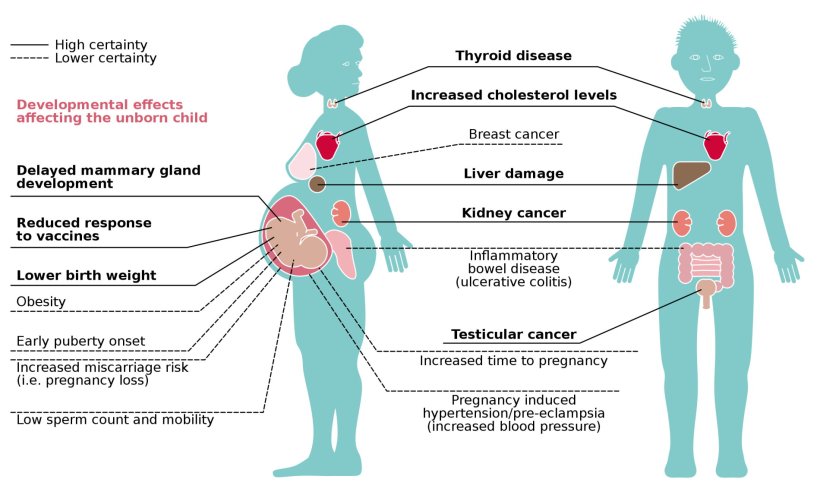Image source: Engin Akyurt auf Pixabay
News • Health impact of PFAS
Study: “forever chemicals” disrupt key biological processes
Exposure to a mixture of chemicals called PFAS leads to alterations in biological processes associated with a broad range of diseases.
A team of researchers from the Keck School of Medicine of USC found that exposure to a mixture of synthetic chemicals found widely in the environment alters several critical biological processes, including the metabolism of fats and amino acids, in both children and young adults. The disruption of these biological processes is connected to an increased risk of a very broad range of diseases, including developmental disorders, cardiovascular disease, metabolic disease and many types of cancer.
Known as per- and polyfluoroalkyl substances, or PFAS, these man-made chemicals are used in a wide range of consumer and industrial products. PFAS are sometimes called “forever chemicals” because they break down very slowly and accumulate in the environment and human tissue.
Although individual PFAS are known to increase the risk of several types of disease, this study, published in Environmental Health Perspectives, is the first to evaluate which biological processes are altered by exposure to a combination of multiple PFAS, which is important because most people carry a mixture of the chemicals in their blood. “Our findings were surprising and have broad implications for policy makers trying to mitigate risk,” said Jesse A. Goodrich, PhD, assistant professor of population and public health sciences and lead author of the study. “We found that exposure to a combination of PFAS not only disrupted lipid and amino acid metabolism but also altered thyroid hormone function.”

Image source: European Environment Agency (original image) Mrmw (vectorization), Effects of exposure to PFASs on human health, CC BY 2.5 DK
To understand the effects that the mixture of PFAs has in the body, the team used blood samples collected from 312 adolescents who participated in the Study of Latino Adolescents at Risk and 137 children from the Southern California Children’s Health Study. They found that all the children and adolescents had a mixture of several common PFAS in their blood including PFOS, PFHxS, PFHpS, PFOA and PFNA. More than 98% of the participants also had PFDA in their blood.
The researchers also measured thousands of naturally occurring chemicals in blood and, using a biostatistical method they developed, they identified how exposure to multiple different PFAS impacted each of these naturally occurring chemicals. This information helped the researchers determine that PFAS exposure altered the way the body metabolized lipids and amino acids as well as the levels of thyroid hormone, an important determinant of metabolic rates.
We are really only beginning to understand the range of effects that these chemicals have on human health
Leda Chatzi
The researchers focused on children and young adults because they are going through critical stages of development that may make them more susceptible to the negative health effects of PFAS exposure. It is also a time when many serious diseases that manifest in adults begin to take root. The researchers added that these results are consistent with earlier studies that showed exposure to individual PFAS in childhood was associated with dysregulated lipid and fatty acid metabolism, which can increase the risk of metabolic disorders and cardiovascular disease later in life.
One finding that stood out, according to Goodrich, was the fact that the PFAS exposure had an effect on thyroid hormone function, which has a critical role in growth and metabolism. Because of this, changes in thyroid hormones play an important role in child development during puberty, which can have important effects on a range of diseases later in life, including diabetes, cardiovascular disease and cancer.
Another important finding was the fact that exposure to a mixture of PFAS, rather than a single chemical of this type, drove the disruption of these biological processes. This finding was consistent across the two cohorts, even though they had different levels of PFAS exposure.
Almost all people in the U.S. have detectable levels of several PFAS, which are in a wide variety of products including waterproof clothing and food packaging, in their blood. An estimated 200 million people in the U.S. have drinking water with PFAS levels that are considerably higher than the levels recommended by the U.S. Environmental Protection Agency in 2022. Some manufacturers have phased out the use of individual PFAS, but the authors of this study conclude that this research shows why it may be more important to regulate PFAS as a class of chemicals.
“We are really only beginning to understand the range of effects that these chemicals have on human health,” said Leda Chatzi, MD, PhD, professor of population and public health sciences and another of the study’s authors. “While current interventions have focused on phasing out the use of individual PFAS, such as PFOS and PFOA, this research shows why the focus should be on reducing exposure to all PFAS chemicals.”
Source: Keck School of Medicine of USC
24.02.2023











